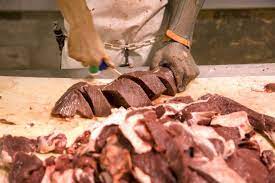Citrox alone or in combination with 1% chitosan on the survival of Campylobacter jejuni in camel meat slices vacuum-packed and stored at 4 or 10 °C for 30 days. The shelf life of camel meat was 30 days longer using 1% or 2% Citrox in combination with 1% chitosan than when using Citrox alone. The reductions ranged from 4.0 to 3.5 logarithmic cycles during the storage period at both 4 and 10 °C. The quality of camel meat treated with Citrox plus chitosan was also better than that of the control meat and of meat treated with 0.85% NaCl.
 Abstract: Camel meat is one of the most consumed meats in Arab countries. The use of natural antimicrobial agents to extend the shelf life of fresh camel meat, control Campylobacter jejuni contamination, and preserve meat quality is preferred. In this study, we determined the antimicrobial effects of using 1% or 2% Citrox alone or in combination with 1% chitosan on the survival of C. jejuni in vitro and on camel meat samples during storage at 4 or 10 °C for 30 days in vacuum packaging. We determined the total viable count (TVC (cfu/g)), total volatile base nitrogen (TVBN) content, and pH of the treated camel meat samples every three days during storage. The shelf lives of camel meat samples treated with 2% Citrox alone or in combination with 1% chitosan were longer than those of camel meat samples treated with 1% Citrox alone or in combination with 1% chitosan at both the 4 and 10 °C storage temperatures, with TVCs of <100 cfu/g after the first ten days and six days of storage at 4 and 10 °C, respectively. The addition of Citrox (1% and 2%) and 1% chitosan to camel meat samples and the application of vacuum storage were more effective than using Citrox (1% and 2%) alone and led to a reduction in C. jejuni in approximately 4.0 and 3.5 log cycles at 4 and 10 °C, respectively. The experimental results demonstrated that using a Citrox-chitosan combination improved the quality of camel meat and enhanced the longterm preservation of fresh meat for up to or more than 30 days at 4 °C.
Abstract: Camel meat is one of the most consumed meats in Arab countries. The use of natural antimicrobial agents to extend the shelf life of fresh camel meat, control Campylobacter jejuni contamination, and preserve meat quality is preferred. In this study, we determined the antimicrobial effects of using 1% or 2% Citrox alone or in combination with 1% chitosan on the survival of C. jejuni in vitro and on camel meat samples during storage at 4 or 10 °C for 30 days in vacuum packaging. We determined the total viable count (TVC (cfu/g)), total volatile base nitrogen (TVBN) content, and pH of the treated camel meat samples every three days during storage. The shelf lives of camel meat samples treated with 2% Citrox alone or in combination with 1% chitosan were longer than those of camel meat samples treated with 1% Citrox alone or in combination with 1% chitosan at both the 4 and 10 °C storage temperatures, with TVCs of <100 cfu/g after the first ten days and six days of storage at 4 and 10 °C, respectively. The addition of Citrox (1% and 2%) and 1% chitosan to camel meat samples and the application of vacuum storage were more effective than using Citrox (1% and 2%) alone and led to a reduction in C. jejuni in approximately 4.0 and 3.5 log cycles at 4 and 10 °C, respectively. The experimental results demonstrated that using a Citrox-chitosan combination improved the quality of camel meat and enhanced the longterm preservation of fresh meat for up to or more than 30 days at 4 °C.
Improving the quality and safety of fresh camel meat contaminated with Campylobacter jejuni using citgrox, chitosan, and vacuum packaging to extend shelf life
Hany M. Yehia 1,2, *, Abdulrahman H. Al-Masoud 1, Manal F. Elkhadragy 3, Shereen M. Korany 3,4, Hend M. S. Nada 5, Najla A. Albaridi 6, Abdulhakeem A. Alzahrani 1 and Mosffer M. AL-Dagal 1







 On the
On the